
Vol. 1, No. 8 Published by India China Division, Air Transport Command March 8, 1945
|
|
|
With Scheduled Jump
Two-way Traffic With States
Hq., Calcutta - The ICD has completed the last link in ATC's scheduled military air transportation around the world.
Brig. Gen. Tunner, in making the announcement, said weekly scheduled flights would be made between India and Australia, with connecting flights from there to the East Indies, the Philippines and Pacific Ocean areas.
The journey, longer than from New York to San Francisco, is the longest scheduled over-water flight in the ATC's globe-girdling system - probably the longest in the world. It exceeds by nearly 1,000 miles the distance from San Francisco to Honolulu, longest previous U.S. over-water hop.
Calcutta Terminal
This new scheduled flight makes it possible for military and civilian personnel traveling for the war effort, to circumnavigate the globe, if duty requires, on a single ticket. An around-the-world flight originating in Washington would take the traveler to Stephenville, Newfoundland; the Azores; Casablanca and Cairo, Africa; Karachi and Calcutta, India; Colombo, Ceylon; Australia; Netherlands East Indies; the Philippines, Guam, Honolulu and San Francisco.
Skymasters Used
The plane carries a double crew, including three pilots, two navigators, two radio operators and two engineers. Thus, the aircraft is kept in continuous operation, one crew sleeping while the other flies.
Primary purpose of the new scheduled flight is to facilitate closer liaison between the India-Burma and China theaters and the headquarters of Gen. MacArthur and Admiral Nimitz.
Four-engined Skymasters used on the flight are equipped with 14 reclining seat chairs and beds. From an electrically-operated galley come hot meals, served en route by the flight clerk. Typical evening meal might include hot tomato soup, hot beef stew with fresh sliced tomatoes, fresh milk, fruit salad, coffee and a selected fresh fruit.
Named the "Down Under Special" by the ICD men who fly it, the plane passes over India, Ceylon and Australia. Only two stops are made by planes en route to the East Indies - one in Ceylon, the other in Australia.
Passengers on the run from the Pacific to India observed damage inflicted by a 100-mile-an-hour hurricane along Australia's west coast. The storm's fury tossed a 40-ton navy landing barge three miles inland to the edge of an airstrip, and a tanker was driven more than 100 yards inshore.
Assembly Line Aircraft Repair Started at 1330
Production Line Maintenance Pours Planes Through Overhauls
1330 BU, Assam - Production line maintenance, a system of inspecting and overhauling aircraft in a continuous flow, has come to ICD.
First of its kind in the division to get into full-scale operation and first anywhere overseas in ATC, this "assembly line" pours aircraft through its successive stages in 20 hours, checking them from props to elevators and putting everything in tip-top condition.
In Butler Hangar
No longer are 50 or 100-hour inspections pulled in scattered revetments. There's no more racing from one end of the field to the other to get a special wrench, or long drives to tech supply for parts. Now everything is concentrated, efficient.
All activity centers in and around one Butler combat hangar. Indian Pioneer labor troops, GIs and officers erected the hangar, raising its canvas envelope by the prop blast of a plane.
Heavy monsoon rain, excessive heat and glare previously had limited the amount of work which could be done. So too, did lack of adequate lighting. Under the old system, with maintenance facilities widely dispersed, 100-hour inspections could be made only in the daylight. In all, a 100-hour check took 36 hours the old way, and the highest monthly total ever achieved was 102 such inspections.
Five Stages in PLM
Working closely with Col. Robert B. White, ICD's chief of aircraft maintenance, Col. William S. Barksdale, Jr., station CO, and Capt. William P. Dunn, base director of aircraft maintenance, developed the new PLM system.
There are five phases to PLM. In the first stage engines are decowled, cleaned and inspected; the plane is washed or sprayed, and carburetor, props, engine mounts, conduits, hydraulic and vacuum systems all get a going over.
The aircraft passes on to stage 2 where radio, electrical and oxygen systems get a thorough testing and renovating. On down the line, in stage 3, power-plant accessories receive attention, safety devices get a going over, and the entire airplane is rechecked, to make certain corrective measures have been properly applied in previous stages. Sheet metal work is done here, too.
'Extra' Stage
At station 4, the plane is jacked up and the landing gear is thoroughly tested, including the retraction of the wheels. Engines get a final inspection at this point. Then comes stage 5, the "proof of the pudding" stage. Engines are recowled and run up, and every gauge on the complicated dash is checked. Hydraulic systems and everything else get a final review.
When engine changes or modifications are needed, an additional stage is added. Such work is performed away from the PLM line, in a nearby nose hangar, so that the movement of other aircraft along the line is not impeded.
The production line system has drawn praise from Brig. Gen. Tunner, and likewise from Maj. Gen. Thomas J. Hanley, Jr., ASC's commanding general, who inspected the new development recently.
South India Labor Unit's Smithy Produces A-1 Work
1348 BU, Burma - Cochin State Labor Unit No. 73, veterans of construction work in the Assam Valley, arrived here recently and became the first group of its kind to aid in the building of American bases in Burma.
Under the command of Capt. C. R. Skill of the British Army, the men from southern India are organized into small groups and assigned to priorities and traffic, the mess hall, and base utilities.
The group working for Capt. L. C. Breen, base engineer, has built a blacksmith shop which is used to fashion tools out of scrap metal. As tools are a scarce item in this part of the world, the Cochin metal masters are an integral part in the construction now being carried on here. Soldiers supervising the India blacksmiths rate their work A-1 and claim it is better than many wartime manufactured tools now being sent to this theater from the West.
Second in command of the unit, and Indian supervisor, is Mr. W. Natason, of Madras. Mr. Natason has been with the unit for three years and, before that, was a mining contractor in many parts of the world. No stranger to Burma, the labor supervisor lived several years in Rangoon, and has also spent 15 years in South Africa. He speaks five Indian and two African tongues, as well as perfect English.
Mr. Natason praises the American GIs and says their co-operation and amiability make his men happy to serve with them in "the battle for Burma."
Pat on Back from Gen. George for February Tonnage
Maj. Gen. Harold L. George, ATC's commanding general, again extends his congratulations to all ICD personnel, this time for February's outstanding performance. In a wire to ICD headquarters, he said:
"It gives me real pleasure to send you my highest commendation for the tonnage carried over the Hump. Considering that February had only 28 days, your Hump lift exceeded that of January. Everyone in ATC Headquarters sends their congratulations on your exceptional performance, especially in view of the difficult weather conditions that confronted Hump personnel during the month."
Old 481, War-weary Veteran, Gets 'DFC' In Assam Ceremony
1328 BU, Assam - C-47 No. 481, a war-weary workhorse, was decorated and rotated in a mock ceremony here last week.
Maj. James A. Dearbeyne, base executive officer, said "This old gal has served the Army well," as he pinned a huge DFC to the nose of the ship. The citation read, in part:
"For flying with her wheels down as well as with her wheels up, over long and hazardous routes; for hauling beautiful USO showgirls for the lovelorn GIs; for courageous devotion to duty; for never going temperamental; for always shaking ice from her wings..."
Back in '42, when 481 was just a gleam in Rosie the Riveter's eye, the War Department began drafting 47s for its new Hump operation. Brand-new 481 got some basic training, and was shipped overseas to India.
Flies All Over World, Never Been to NYC Just 150 Miles Away
1304 BU, India - Lt. Robert Demarest, Springfield, Mass., a pilot flying from India to the Netherlands East Indies, on the longest scheduled over-water flight in the world-circling Air Transport Command system, can lay claim to a unique honor.
With more than a thousand hours of flying time to his credit, he has been stationed in Alabama, Louisiana, Mississippi, Missouri, California, Florida, Wisconsin, Illinois and India since joining the Army and has flown through such countries as Puerto Rico, British Guiana, Brazil, Africa, Arabia, India, Burma, China, Ceylon, Australia, New Guinea and the Netherlands East Indies.
Yet he has never been to New York City, which is less than 150 miles from his home.
Phos Bomb Story Gets Under Skin of Elmira Flier
He Collects Grenades from Chinese Passengers in a Hurry
1333 BU, Assam - History isn't going to repeat itself while T/Sgt. Maury Jungman, Elmira, N.Y., flight radio operator, is a crew member of a plane.
While crewing a ship somewhere over China, he glanced at the front page of a recent issue of the HUMP EXPRESS and read the article about a crash landing brought about by the explosion of a phosphorous smoke bomb dropped by a Chinese soldier.
The radio operator glanced up at his passengers, a plane load of Chinese soldiers in full field pack. With 1,200 hours in flight since coming to India 16 months ago, Sgt. Jungman resolved not to take any unnecessary risks.
He strode up and down the row of seats and confiscated hand grenades from every passenger. "You'll get them back after we land, pals," he told them. The grenades were gathered in two steel helmets, and not until the last one was placed in his care did he breathe easily.
Nine Top Ranking Chinese Newsmen Fly to New Road
1340 BU, China - Nine top ranking Kunming newspapermen were transported from this base in an ICD passenger plane to a point in Burma where they will cover movement of traffic over the recently opened Stilwell Road bringing materiel to their native land.
With them was Mr. Morgan Hsu, Chinese military censor. The correspondents and the newspapers they represent were:
Chen Min Hsuan, Min Kuo Daily News; Yu Siang, Yunnan Daily News; Li Ho-sun, Chen Yi Pao; Cho Kuan Yuan, Central Daily News; Fu Keng Pei, Sao Pang Pao; Wu Er Nan, Morning Post; Chen Fu-wei, Chung Chen Daily News; Loh Chiu-tao, Chinese Ministry of Information; Chang Son Li, Central News Agency.
|
Jumps in Civilian Life, Flies
800 Hours in ICD Without One
Advertising Skylarks During His Years
Of Varied Commercial Flying
Hq., China Wing, Kunming - Capt. Earl R. Stein has flown some 800 hours, encountered a few Japs, and participated in airbase evacuations throughout ICD without having to hit the silk a single time, yet he holds the world record in number of parachute jumps.
Capt. Stein made all his jumps from a special plane as the famous "Bat Man" of pre-war flying circuses. The total comes to 629 jumps in air shows all over the U.S.
Neon Lights
Before the war Capt. Stein and two colonels were known as the Linco Flying Aces and flew under contract to the Ohio Oil Co. Their aerial advertising stint called for skywriting, banner towing, and aerial acrobatic shows. One of their planes was equipped with neon lights to advertise the product at night.
The first "Bat Man" display was put on by another daredevil named Clem Sohn, who since has been killed. Capt. Stein then took up the idea and perfected the stunt.
Experimenting with wings and tailpieces, he made 13 different outfits. One sensational costume he wired for lights on the edges of the wings and tailpieces for night jumps. For his daytime spirals he had a smoke belching suit which patterned his flight in colored smoke.
Went to South America
Control of these wings, he says, is amazing. At the Cleveland Air Races in 1939, he jumped from 10,000 feet, circled the airport leisurely three times then landed within a tiny designated circle. After a jump the average speed, while soaring, is about 60 mph, necessitating use of the 'chute for the landing.
An all around airman, Capt. Stein has flown, jumped, and defied gravity for practically all the National Air races and put on several shows for the New York World Fair. For a little serious flying he went to South America and hauled oil from Columbia and Venezuela.
When the war came along he sold his plane and became a civilian instructor for the Army, during which time he added 2,500 air hours to his 2,000 civilian flying hours. He came into the Army a year ago and arrived in ICD nine months ago.
His flying experience here hasn't been without adventure. He has participated in the Kweilin evacuation and several others which took him well behind the enemy lines. At one time a bomb exploded a few yards ahead of him and another time, he and several other pilots encountered 12 Jap Zeros in a traffic pattern. The two ships flying alongside Capt. Stein's were shot down and two others were destroyed on the ground.
The captain now is operations officer here.
Brothers Separated For 28 Months Get Together in Calcutta
Hq., Calcutta - This base was the scene of a joyous reunion this week between two brothers who had not seen each other for 28 months.
Sgt. Urban Cartier and Cpl. Jacques E. Cartier, both of Los Angeles, had been separated since Nov. 7, 1942, when Urban joined the Army. Jacques followed his brother into the service on Jan. 11, 1943.
Urban has been in India for 20 months, assigned to ASC and stationed in Calcutta. When Jacques came over about a month ago from Cairo, his ATC assignment transferred to the 1311 BU, India, he lost no time in notifying his brother, and at the earliest possible moment he arranged for a pass and flew to Calcutta, to remain with him here for three or four days.
Sgt. Urban, 37, is a mess sergeant, while Cpl. Jacques, 33, is an aerial engineer. Both are married and their wives are living in Los Angeles while they are serving overseas.
Treetop Op Now Has Fine Tower
Recalls Arboreal Era from His New Streamlined Edifice
1332 BU, Assam - "The good ol' days" to S/Sgt. Jacob Rabatin, Jr., of Chardon, Ohio, probably do not bring back memories of months spent as operator in the field's first control tower 60 feet above the ground in the branches of a tall tree near the runway.
Nevertheless, now that he has more modern quarters in the operations building in which to work, he likes
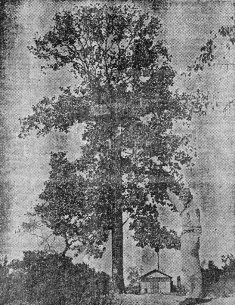 An indication of the once rougher days, this tree with its wooden "roost" still stands at 1333 where it served as
control tower. S/Sgt. Jacob Rabatin points to the primitive perch where he, as tower operator, held sway from May to
September 1943.
An indication of the once rougher days, this tree with its wooden "roost" still stands at 1333 where it served as
control tower. S/Sgt. Jacob Rabatin points to the primitive perch where he, as tower operator, held sway from May to
September 1943.
|
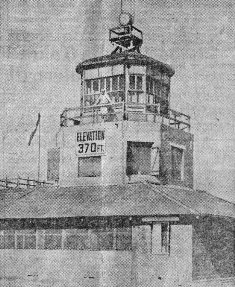 With 15-hour days, Jap air raids, and many monsoon soakings now mostly memories of his first days here, S/Sgt. Rabatin
smiles as he looks out over the runway from the cat-walk of the new building which houses the control tower activities.
With 15-hour days, Jap air raids, and many monsoon soakings now mostly memories of his first days here, S/Sgt. Rabatin
smiles as he looks out over the runway from the cat-walk of the new building which houses the control tower activities.
|
A wooden ladder, which he climbed four times a day, led up the trunk of the tree to the roost where Rabatin and two other men on the shift held forth during the day. Because of lack of proper night flying facilities at that time, only daylight operations were being conducted, and Rabatin's shift was on duty from 5 a.m. until the last plane returned at night.
A canvas tent at the foot of the tree housed the radio transmitter. A tarpaulin over the roof of the "roost" was intended as protection from the monsoon rains, but Sgt. Rabatin smiles as he recalls the many drenchings both operators and equipment received. In spite of these handicaps, 100 landings a day often were accomplished. In addition to ICD cargo planes, a B-24 bomb squadron was operating from the field.
Now Sgt. Rabatin looks out over the runway from a modern glass-enclosed tower.
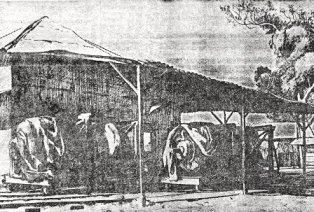 Details of one phase of overhaul operations at an Assam base were caught in this brush drawing by Capt. James P.
Scott, ICD artist. The engines, shrouded to keep out dust and dirt, are on their way along a miniature railroad
converted to aircraft use after ATC moved into the base.
Details of one phase of overhaul operations at an Assam base were caught in this brush drawing by Capt. James P.
Scott, ICD artist. The engines, shrouded to keep out dust and dirt, are on their way along a miniature railroad
converted to aircraft use after ATC moved into the base.
|
Letter from 'No. 1' Reveals Evidence of
Chinese People's Feeling for Passing Birdmen
Bailouts Bring Back Fond Testimony from Head of Hilltown
1328 BU, Assam - A crew that had bailed out over the Hump returned here bearing concrete evidence of the feeling of the hillfolk in regard to the planes that fly over their villages day and night.
The crew - Capt. Frederick J. Telecky, pilot; 1st Lt. Gordon P. Malone, co-pilot, and Sgt. George P. McBride, radio operator - brought with them what they had thought to be a pass of some kind for use in the various Chinese villages they passed through. When the message finally was translated it read something like this:
Dear Allied Friends:
We are very grateful indeed for your kindness to help the weak nation and come to China to win the war. It is very lucky that all of you landed here safely when your plane was in accident.
We regret very much that we cannot speak your language to express out gratitude to all of you and that we have nothing good to entertain you, owing to our poor circumstances in this place for which we feel very shameful indeed.
Because of having with you great duties that make it impossible for you all to stay in this place with us, we think it is necessary to write you these few lines to express our thanks and belief that the final victory will be ours.
 After 23 years as a professional musician, Larry Funk, nationally known
orchestra wallah, still
finds he can learn plenty about the music business. Here he receives lesson number one from a Gurkha soldier in
the use of the flute, favorite musical instrument of these tough fighters when they're on the march.
After 23 years as a professional musician, Larry Funk, nationally known
orchestra wallah, still
finds he can learn plenty about the music business. Here he receives lesson number one from a Gurkha soldier in
the use of the flute, favorite musical instrument of these tough fighters when they're on the march.
|
Funk's '1000 Melodies' Are
Lingering On At 1332nd BU
1332 BU, Assam - Remember the popular dance music of Larry Funk and his "band of a thousand melodies," whose smooth music came over NBC sustaining programs for five years, the "idol" of the college proms, and the dance hall veteran of nearly every principal city in America?
Pfc. Larry Funk, of the special service section of this base, is the same man, and he has an orchestra too - but the men in his department say this one is the "band of a thousand headaches."
Larry's home is a farm in Bloomington, Ill. He has been in the Army for two years, with five months overseas. On entering the service he broke up his band, which ended a siege of setbacks caused by the drafting of his musicians. During a short period he had to acquire 43 new men to fill vacancies.
Urge To Travel
In the music business for 23 of his 38 years, Larry in 1927 started playing on regular programs several times a day with NBC. During the five years this contract ran he played on such well known spots as "Rise and Shine," "Headliners," "Morning Melodies," "Tea Times," "Dancing Melodies" and others.
In 1932 Larry started his boys on a nationwide jaunt that covered 500,000 miles. Along the way he discovered such greats as Helen O'Connell, formerly with Jimmy Dorsey and later in the movies; Vaughn Monroe, who was found by Larry in Columbus, Ohio, and played with him for three years before forming his own outfit; Artie Shaw, jazz pride of the bobby soxers, who played sax for him at one time; and Claude Thornhill, pianist, whose orchestra ranks among the top dance units in the country.
Dance Project
Larry has been at this base since Jan. 14. He found on his arrival the remnants of a small base orchestra that had just been disbanded. Investigating the talent, he brought together a group composed of three trumpets, trombone, saxophone, piano, bass violin and drums.
Larry has dreamed up a GI dance project for this base. He believes he can gather 20 or 30 attractive girls from the surrounding tea plantations and small communities. He would invite about 100 GIs at a time.
ICD Men Stick To Ground, Pilot Motor Vehicles
Former Greyhound Driver Leads Convoy to Burma
1348 BU, North Burma - Twenty men from this base passed up ICD's airlanes from India to Burma last week and instead elected to drive vehicles from India over the Stilwell Road.
The men were flown from North Burma to an Assam base and early one morning last week started the convoy of jeeps, trucks and weapons carriers rolling along the new road.
Rude Awakening
After driving steadily for 18 hours the first day, the convoy was halted in the mountains and the men bedded down in their vehicles for the night. The next morning, they were awakened by ice-cold wind and flying stones from the propwash of airplanes. They had parked opposite an airstrip.
Truckmaster of the convoy was Sgt. George O. Bayne, who hails from a place called Travelers Rest, S.C. He is a veteran of five trips over the former Ledo Road. A onetime Greyhound bus driver, Sgt. Bayne set the pace for the bouncing, dusty line of vehicles. The second evening the convoy, completely intact, ground its way into this North Burma base.
An Embarrassing Incident
M/Sgt. Oscar R. Gordey of Glenmora, La., and Pfc. Tom Fowler of Atlanta, Ga., almost missed the convoy at one place. They were eating in a restaurant when a local merchant strode in with two MPs and pointed them out as a couple GIs who had "lifted" his shop.
Since their estimated time of arrival didn't jibe with the time of the crime, the MPs were assured it was somebody else.
Doubleheader Takes To 'Road' in Khaki Amusement Schedule
Two ICD soldier shows - "All Clear" and "Basha Brigadiers" - will hit the air in the next few days to entertain men in the field.
"All Clear" features Leon Fields as MC; Vince Haydoch's dancing; Mel Winter's piano playing; Pete Badrich and his "Sub-private Oscar O'Connor," the dummy whose specialty is picking on colonels and generals; Tony Martin's singing, and Art Young's performance on the fiddle.
Tentative schedule for "All Clear," subject to such changes as may be imposed by the vagaries of flying weather is: 1328, March 9; 1327, March 10; 1330, March 11; 1337, March 12; 1332 March 13; 1333, March 14-15; 1348, March 16; 1347, March 17; 1345, March 18; 1346, March 19.
"Basha Brigadiers" will feature Raymond Grey, a Brooklyn MC; Gordon Bishop, Hollywood pianist; Stan Hamilton, a Kansas Robert Beanchley; Clarence Richardson, Peterborough, N.H. violinist; Alfred Tellinghuisen, Allison, Iowa, vocalist; Ray Peralta, Los Angeles tap dancer, and Glenn parker, Atlanta guitarist.
According to present plans, the "Brigadiers" will leave India about March 12 with their first China show scheduled March 14. From then until March 30, they will play stations and detachments in the China wing. April 1 to 5 will find them touring the Bengal wing, and from April 7 through 15 they will perform in the Assam wing.
Doggies Ape Radio Wolves to Get Two Mice in Blind Try
1305 BU, Calcutta - Ten soldiers from this base took the stand one evening and knocked themselves out trying to convince an invisible female, by means of a telephone, that they were the one man on this base with whom she would most like to have a date.
The setup was similar to the "Blind Date" show heard Stateside, only this base used makeshift props and dummy telephone systems hooked to two microphones. The boys were separated from the two girls by a large wooden frame, colorfully decorated with and old piece of Indian rug cloth. Two U.S. lady-soldiers were imported for the occasion - Sgt. Sylvia Katz and Cpl. Marjorie Solum, both stationed at a nearby Calcutta base.
S/Sgt. Arkey Evers and Pvt. Tucker Steinbeck walked off the stage victorious over their eight other contestants from all over the base. They will be guests of one of Calcutta's popular niteries, with their "dates" of course, as the reward. That night, the management said, everything would be free. The "blind date" show is sponsored by special service.


Steady Does It!
Its a rare week now when one of the Assam Valley stations of ICD doesn't smash all existing records. For instance, just recently, one station flew 29 more Hump trips in 24 hours than ever had been made from any field before.
Such record days serve their purpose. They teach field personnel to operate under pressure, and they teach adaptability, for pencil-wallahs become freight loaders and truck drivers. The pitching in that everyone does builds a real family feeling, too, with the result of boosting morale sky-high.
But there's another side to the picture. In the rush to boast over umpteen more trips than the other guys at the XXX base unit, careless practices are bound to creep in. Vehicles are driven 'round and 'round at a dizzy pace as MPs tear their hair. Tires, already critically short, get excessive wear, and accidents are nearly a cinch to happen. And near the end of the day, planes are likely to be sent out with minor troubles that may grow into major ones overlooked, as engineering is too busy to fix them at the time.
Spacing of planes may suffer, too, with one taking off in the prop wash of another ahead, making accidents all too likely. Then, when the record-buster is over, the normal human reaction sets in. Everybody says, "We done it, kid, let's relax." And later, the headaches start back in engineering.
To make the record in the first place, engineering had to get all ships possible into commission on the target date. And, because all ICD planes fly 'round the clock, they tend to get about the same number of hours in a given period. So the vicious cycle starts, when they all need 25-hour inspections at once. Then it's a 50-hour. Then 100, maybe even carrying on to the point where a dozen planes need engine changes at the same time.
In other words, record days mean peaks and valleys, not a steady, ascending operation. And they cause headaches across the Hump, too, for they pour a torrent of cargo into the stations in China one day and very little the next. China bases, hampered by lack of ground transportation, scarcity of unloading equipment and troubles with coolie labor, can care for only so much freight at once. When that mark is passed, efficiency goes to pot, and the harried P & T men stumble over themselves trying to put five engines on a dock built for two.
Far better than a record day is a record week or a record month, with each day's operation growing a little from the day before. Then, there's no brash "cowboy" operation will all its wastefulness, no pressure that nears the unbearable. No one does too much, but everybody does enough. In short, "Steady Does It."
Battle Credit for ICD
Personnel of ICD now share credit officially in the combat operations of Maj. Gen. Claire L. Chennault's 14th Air Force in China. In a letter to Brig. Gen. Tunner, written from 14th Hq., the following accomplishments are listed for a 30-day period (quoted from the letter):
1. On offensive and defensive operations 14th Air Force aircraft accounted for 334 Jap aircraft destroyed, 48 probably destroyed and 216 damaged. Ratio of enemy aircraft destroyed and probably to United States aircraft lost through enemy action is 12.7.
2. Bombing attacks on Jap shipping accounted for 13,500 tons sunk, which does not include 89 miscellaneous boats. Damaged ship and probables totaled 58,900 tons, not including 716 miscellaneous type vessels and three naval vessels.
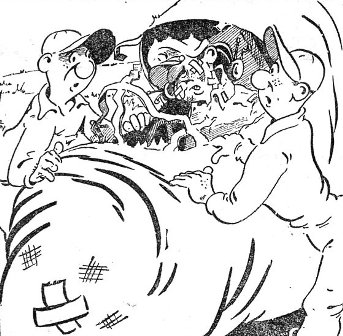 "Anything wrong, Sir?"
"Anything wrong, Sir?"
|
3. Total assessment in occupied China, French Indo-China, Thailand and Burma against installations, bridges, railroads and personnel runs to large proportions and is an important part of the month's activity.
The letter concludes: "Credit for these successful operations is shared with the personnel of the ICD-ATC for their efficient operation of the supply line to China."
It is expressions like this one from various commands that best reflect ICD's contribution to the war. The growing total of military cargo flown over the Hump by the various routes and from the various airfields now used by the command, and the mounting number of passengers flown, billeted and fed make nearly unbelievable reading, even to higher authorities back home. Today's tonnage totals far exceed the most optimistic estimates of official circles a year ago.
Each of us, whether in India or China, in an office or on the line, pilot or paddle-foot, has his part in this truly American success story. Each of us knows that it's modern American management, Yankee ingenuity and a willingness to work until "achin' back" becomes a fact, not a funny remark, that has turned the tide.
Now, with convoys able to move over the Stilwell Road to China and with ICD's deliveries moving ever upward, China can be supplied with plenty of arms and essentials for a full-scale offensive against the Japanese. Thus the war may be shortened, for Chinese pressure from inland toward the sea will effectively trap the Jap when U.S. men in khaki start pushing him from the coast.
1330 BU, Assam - The largest crowd of athletes and spectators ever assembled in Assam watched India sweep to first place in the mammoth International Olympic games here in which athletes of five nations participated. Tall, lean African Negroes, massive Punjabi Sikhs, short, wiry Assamese, dark-skinned Italians, and suntanned British and Americans sent their best athletes into the battle of sportsmanship. Capt. Gordon Stars High point man was a midget flash, Ghulam Mohammed, who turned in a stellar performance for India. This thin, will-of-the-wisp, 5 foot 6 inch Indian sped so fast over the grass that contestants rarely saw anything but a whirling maze of legs and back. He took the 100-yard dash in 9.9 seconds (two stopwatches had him at 9.8). Another outstanding star was Capt. Alexander Gordon of St. Louis, Mo., who turned in crack runs to win the half mile, the mile, and anchor the U.S. winning team in the international medley relay. His time of 2:02.2 in the half mile (880) was better than any recorded in India in recent times even though it was run on a circular fifth-mile turf track. East African Units Three great Punjabi Sikh runners were discovered in the 5-mile. The first mile was run around the mile-long race track, then three mile on rough, dusty roads, and finally the last mile over the race track again. At the four-mile mark the three Sikhs were running easily, side-by-side, almost in step. The blanket finish saw Naik Sadhu Singh nose out Lance Naik Jogindar Singh and Sapoy Sadhu Sing, while the time, 29:30.4 was so fast that some of the 53 entries finished one mile behind. The scissors jump was no match for the bobbing weave, the upward lurch, or the what-have-you of Jemadar Nazar Hussain Shah, wearing the colors of India, in the high jump of 5 feet 7 and 3/4 inches. American negroes had expected to figure prominently in the sprints, but Okea, of East Africa, breezed away with the 220-yard dash in 23.7 and the 440 in 53.4. He finished 30 yards ahead of his closest contender in the 440. A surprise to the British was Pfc. Irving Valentine throwing the cricket ball (not a baseball) for the U.S., who won with a tremendous heave of 314 feet 6 inches. This may prove an all-India record.
In Constructing Handsome Base On Site of Old Indian Village Starts Face Lifting Drive At Fast Expanding Airfield 1304 BU, India - In the course of one recent day, nine generals arrived here. It was an unusually busy day with respect to arrivals of "very important persons" at t his busy field, but more rare is a day on which not one VIP arrives. Each one finds a staff car and baggage transportation waiting when he debarks - and nearly every one is personally greeted at the plane by Lt. Col. Charles A. McGarrigle, CO. Riding out to meet celebrities and "big brass" is only one small part of the young colonel's jeep-ubiquity. His slight, vigorous, conspicuously youthful figure is a frequent sight in the mess halls, down on the line, and in any office of this sprawling ICD establishment as he makes his almost daily informal circuit of every section of the base, just jeeping up and jeeping away again. New Buildings During the six months since he assumed command, the base has changed perhaps more than any in ICD. It was once the site of a populous Indian village - the present headquarters, in fact, being a jail for political detunus. A program of building-beautification and landscaping of the grounds has given the base a thorough face-lifting, and it's as attractive as any Army post could be under the circumstances. A service club, the equal of any in the division, was opened on Christmas Day. The mess halls have been renovated Indian kitchen and mess workers have their own shower facilities and tents for personal use. A new post office has been established in the quarters formerly allotted to the PX, which has moved across the way to a new building. Inauguration of a camp newspaper, opening of a softball field, and foundation of a top-notch education program are other features of 1304.
Son of Officer All eyes are on the man at the helm - who, at 26, one of the youngest airfield commanders in India, holds the responsibility of commanding an important military base and a thriving metropolitan passenger and cargo terminus. Lt. Col. McGarrigle, son of an Army officer, attended the University of San Francisco, and in 1938 decided to follow his father's precedent and enlisted in the sixth CAC at Fort Winfield Scott, San Francisco, where he served until his appointment as a flying cadet in 1940. After training at Randolph Field, San Antonio and Barksdale Field, Shreveport, he was commissioned in July, 1941. He had been executive officer at 1304 until his appointment as CO, and previously was flight operations officer at another nearby ICD base. Co. McGarrigle is a native of Long Beach, Calif., where his wife and 2-year-old daughter are making their home. Tire Repairing Easier Problem With New Device Handy Portable Repair Kits For Use Throughout Division Hq., Calcutta - ICD has developed a method of plugging tire holes, which is expected to contribute a great deal to the rubber conservation program. In line with the AAF rubber-saving plan, and Brig. Gen. Tunner's pledge that ICD will strive to better the 25 percent increase in service goal set by Gen. Arnold (HUMP EXPRESS, Jan. 25), the new method strikes at the greatest single problem of tire conservation in the division - the frequency of gashes caused by stones on the runways of China. The new method features a portable repair kit containing a gun which forces the repair gum tightly into the break by pressure. As soon as a plane lands, a tire maintenance man can run out with the portable kit, remove small stones, and make needed repairs instantly. These frequent systematic and thorough inspections by maintenance personnel contribute much to flying safety, as inspectors will see that unsafe tires are immediately removed. Hundred-R Purse Is Put Up For Conservation Limerick Want to win a hundred chips pretty easy? As an adjunct to the AAF rubber conservation program, and particularly to ICD's effort to beat the conservation goal of 25 percent increase in tire service, Maj. A. A. McCarthy, ICD rubber coordinator, offers a prize of Rs. 100 to the GI writing the best limerick to be used in posters and other conservation publicity throughout the division. The contest is open to all ICD enlisted personnel exclusive of Hq., Calcutta. You may submit as many limericks as you wish. Though there is but one prize offered, all limericks submitted will become the property of the supply and service section, ICD. The contest will end at 5 p.m. on April 15. Any phase of rubber conservation - aircraft or vehicle - may be used as a theme for the limerick. Here are three, to get you into the mood (These are provided by S & S as examples, and of course are not eligible to win the bahout rupees).
Do you get the idea? Go to work on it, and here's hoping YOU will be the one to grab the Rs. 100.
In Division's Course Of Human Events Some Comic, Some Valued Inventions Answer Rough Needs Good Old Yank Ingenuity Has Field Day For Self Necessity is the mother of invention - at least so goes the saying - and judging by the gadgets, devices and inventions which have popped up throughout the division the needs are plentiful. On the line mechanics, welders, tiremen, all work to facilitate their jobs. In ICD, weather and other conditions dictate a need for many things that QM does not stock. So the GIs get busy, and devices for saving time, affording greater comfort, or lightening a job, soon come into being. Tire-busters Built At 1305, Cpl. Wallace Green designed a "tire-buster" which he claims will break two firmly stuck tire beads from the rim in a maximum of five minutes. S/Sgt. John J. Robinson and T/Sgt. Andrew Berg constructed the machine and now are working on a plan of Green's for an electrical tire-buster. S/Sgt. Pearlie Tatum, of 1347, used old axles, yokes and jacks and came up with a machine that does the same thing. He calls it a "bead-breaker" and guarantees it to work every time. Pfcs. Sam Skurow and Charles Foster, of 1339, used old C-87 parts, bomb crates and armor plate for their version which fits two different sizes of aircraft wheels. Skurow wasn't satisfied with the bead-breaker and, deciding to make a few points with the dentist, built him a light and instrument stand. 'Scrapocycle' Dreamed Up Using a Curtiss diagram, S/Sgt. Carl G. Boettin, of 1333, built a landing gear dolly which makes it possible for one man to remove a 400-pound landing gear almost without effort. The operation formerly took three men three times as long.
"Rosie the Riveter" will get around a little more if she switches to the mobile power unit Sgt. Charles W. Camden uses for aircraft sheet metal repair work at 1330. The unit mounts a grinder, vise, racks for supporting electric cords and air hoses. An air compressor furnishes power for riveting guns, drills and screwdrivers. Blueprints of the unit have been made, and all ICD installations have been urged to build similar units. More mobile equipment, originally destined for personal use, was built by M/Sgts. Aaron F. Baker and Walter H. Fleenor, Sgt. Anderson M. Linton, and Cpl. Robert Hunt, all instructors in the engineering school at 1333. Tired of walking between widely dispersed buildings, they put together scrap pieces of pipe, tires from an old oxygen cart and a motor from a broken down water pump - and out came their "scrapocycle." The economical little scooter will be utilized to deliver messages, so the instructors will be back on the uppers again soon. At 1326, the engineers are stretching things a bit. M/Sgt. Edward C. O'Neal and S/Sgt. Elmer Jaeger made a gadget for stretching bungee cords to avoid the old grunt and groan accompanying the installation of the cords on airplane tail wheel assemblies. After Cpl. Lester W. Ogdahl, 1332, broke his power saw, he looked forward to a month's layoff while he waited for another one. Then his conscience began to bother him and he went ahead and built one from fabric pulleys and a pile of old lumber. Now business goes on as usual in the carpenter shop. To stabilize things a little, T/Sgt. Arnold H. Hansen went to work on a gyro instrument tester at 1328. Before he invented the tester there was no sure way of testing the delicate artificial horizon and gyro compass. The new tester provides an accurate check and is simple to operate. The instrument tested is exposed to the same conditions it would encounter in actual flight. Mobile Prop Shop Another mobile unit is a crew chief stand built at 1347 around an engineering tug. Equipped with special tools incidental to propeller troubleshooting and repair, lights for night work, and awnings, the new stand permits repairs, removals and installations in any kind of weather. The mobile prop shop is the work of T/Sgt. Frank Prabel, Sgt. Hobert Montgomery and Pvt. Frank Collins. catching the same fever at 1327, Capt. Charles M. Cochrane, T/Sgts. John Cranford and Thomas Mahoney spent their spare time developing an engine shipping stand. They made it from the forward half of a regular engine mount. The new stand makes it possible to ship an engine with accessories and cowling. Formerly crews would spend three to six days removing accessories from the old engine, installing them on the new one and then mounting it.
Water Heaters Devised Still "on the line" - but this time in the mess hall - T/Sgt. Edward J. Docherty, 1340, added another innovation to the long list of inventions. To wash mess trays with drainage water was the problem. Sgt. Docherty made several heating ovens through which water is circulated and boiled. A system of intricate plumbing leads the water into the mess hall where the supply is controlled manually. If American and Allied generals, stopping at 1333 en route to and from China, escape without a case of "GIs" after eating at the line mess, they can thank Mess Sgt. William H. Raper and the hot water heater he made for sterilizing trays and other equipment. The water heater, made of old drums and salvaged piping, burns discarded aviation oil. Musicians, Too At another China base, the evenings got a bit too chilly, so T/4 Troy D. Mason and T/5 Earl O. Deiber once again put the famous Yankee ingenuity to work. They emerged with a heater made from salvaged stove pipe which burns old crankcase oil. It will easily heat a six-man tent. In the lighter vein, a couple of musicians at 1333 concocted an "electra-ccordion." T/4 Francis Cianella was tired of being outblasted by trumpeters and drummers. He and T/3 John V. Bauer, Jr., attached an amplifying system to an accordion. They guarantee it to outblast any trumpeter or drummer who wants to compete. 
A Saree Situation - Narrowly Skirted When a hospital unit near an advanced ICD section was rotated to the U.S., a group of nurses found themselves sorely distressed over grass skirts and sarees. The girls spent a long time in the Fiji Islands before coming to India and had picked up a collection of curios, including grass skirts, as souvenirs. During their stay in India they bought sarees and other items.
Anxiously awaiting rotation and expecting to go by boat they were happily surprised upon learning that arrangements had been made for travel to Uncle Sugar by ATC. But that brought up a problem. With only 65 pounds of baggage allowed, either the accoutrements or some other luggage would have to remain behind. Personnel of the detachment were called upon to act as King Solomon for the perplexed nurses, and came through in fine style. Arrangements were made to ship some less important items by QM and the grass skirts and sarees are now winging their way homeward. Medical officers who accompanied the unit have promised a picture from Miami's shores of a few well-traveled nurses wearing the grass skirts and sarees in question. Karachi Fuel Servicers Set Record To Shoot At 1306 BU, Karachi - A Karachi and possibly ICD-wide record for fuel servicing of planes was set when nine GIs on the eight-hour swing shift poured 57,150 gallons of gas into 22 different ships. The record was set despite the fact that one of the servicing units was deadlined for repairs. In addition to the planes fueled, one C-46 was drained. The planes serviced included 12 B-29s, as well as five C-46s, and 3 C-47s. One B-25 and one C-54 also were included in the total. Sgt. E. B. Baker is the crew chief in charge of the men who set the record. Others in the group are: Cpl. M. J. Talbot, Pfc. R. C. Emmert, Pfc. T. Gonsalves, Pfc. L. E. Williams, Pfc. A. Kudranetzky, Pvt. W. J. Brown, Pvt. E. G. Claunch and Pvt. G. Engel. HUMP EXPRESS is the official newspaper of the India-China Division, Air Transport Command, APO 192, c/o Postmaster, New York, N.Y., and is published by its Public Relations office. Camp Newspaper Service and Army Newspaper Service features are used, reproduction of which is prohibited without permission of CNS and ANS, 205 East 42nd St., New York, 17, N.Y. Other material is submitted by staff members, ICD-ATC base Public Relations sections and other soldier correspondents. Printed weekly by the Hindusthan Standard, 3 Burman St., Calcutta, India, and distributed each Thursday. Passed by U.S. Press Censor for mailing.

MARCH 8, 1945 Original issue of HUMP EXPRESS shared by CBI veteran Grover P. Fike Copyright © 2008 Carl Warren Weidenburner TOP OF PAGE PRINT THIS PAGE ABOUT THIS PAGE E-MAIL YOUR COMMENTS PREVIOUS ISSUE HUMP EXPRESS BASE NEXT ISSUE |
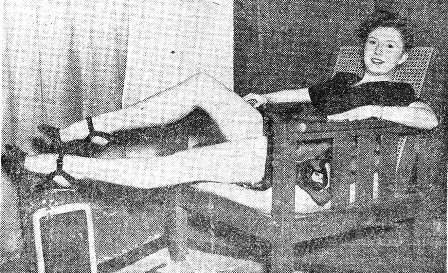 There are occasions when Ye Chicken Eds feel that they are wasting time and space in writing descriptive matter,
and this is one. The speechless-leaving creature is Betty Lynn, of the USO camp show called "Smoke Rings," which
has been over here for a couple of months.
There are occasions when Ye Chicken Eds feel that they are wasting time and space in writing descriptive matter,
and this is one. The speechless-leaving creature is Betty Lynn, of the USO camp show called "Smoke Rings," which
has been over here for a couple of months.
 Capt. Stein in his "Bat Man" outfit in which he defied gravity to the edification of huge audiences at National
Air races and the New York World Fair. The average speed of descent in the Bat Man costume is about 60 mph from a
height of 10,000 feet.
Capt. Stein in his "Bat Man" outfit in which he defied gravity to the edification of huge audiences at National
Air races and the New York World Fair. The average speed of descent in the Bat Man costume is about 60 mph from a
height of 10,000 feet.
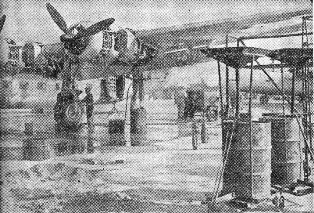 Planes at 1330 BU now get their 50 and 100-hour inspections and overhauls on the "assembly line" system, just like
a modern industrial plant back home. At station 1, pictured here, engines are decowled, cleaned and inspected.
Exterior and interior of the plane are cleaned, washed or sprayed. Carburetor, props, engine mounts, conduits and
hydraulic and vacuum system get a once-over.
Planes at 1330 BU now get their 50 and 100-hour inspections and overhauls on the "assembly line" system, just like
a modern industrial plant back home. At station 1, pictured here, engines are decowled, cleaned and inspected.
Exterior and interior of the plane are cleaned, washed or sprayed. Carburetor, props, engine mounts, conduits and
hydraulic and vacuum system get a once-over.
 Rolling on down the line to station 4, the plane is jacked up and retraction of the gear is worked over.
Engines get a final inspection then are partially recowled. Wheels, tires, brakes and gear are retested. It takes
four hours for a plane to go through each of the five stages.
Rolling on down the line to station 4, the plane is jacked up and retraction of the gear is worked over.
Engines get a final inspection then are partially recowled. Wheels, tires, brakes and gear are retested. It takes
four hours for a plane to go through each of the five stages.
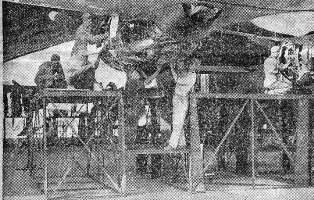 Radio and electrical systems are gone over with a fine-toothed comb at station 2. Coils and magnetos are checked,
spark plugs changed, compression tested. The oxygen system, so necessary in high-altitude Hump operations, gets a
check-up. Wiring, switches and electric meters are tested, along with lighting.
Radio and electrical systems are gone over with a fine-toothed comb at station 2. Coils and magnetos are checked,
spark plugs changed, compression tested. The oxygen system, so necessary in high-altitude Hump operations, gets a
check-up. Wiring, switches and electric meters are tested, along with lighting.
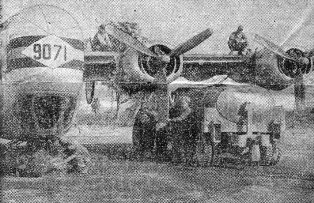 Station 5 is outside the hangar. When the plane arrives here, props are pulled through and the plane is pre-flighted.
The engines are run up, checked for maximum rpm. Superchargers and hydraulic pressure get a final testing and all gauges
are carefully inspected. The plane then is cleared to the air freight section for loading, and once again goes back
on the Hump run.
Station 5 is outside the hangar. When the plane arrives here, props are pulled through and the plane is pre-flighted.
The engines are run up, checked for maximum rpm. Superchargers and hydraulic pressure get a final testing and all gauges
are carefully inspected. The plane then is cleared to the air freight section for loading, and once again goes back
on the Hump run.
 Power plant accessories receive the attention of highly trained specialists at station 3. A general aircraft
check at this point determines the soundness of work done at previous stations. Attention is centered on safety
devices, the automatic pilot and the instruments. Superchargers are checked by skilled hands and sheet metal work
is done in a hurry. Special stands shown in the picture were built for this job.
Power plant accessories receive the attention of highly trained specialists at station 3. A general aircraft
check at this point determines the soundness of work done at previous stations. Attention is centered on safety
devices, the automatic pilot and the instruments. Superchargers are checked by skilled hands and sheet metal work
is done in a hurry. Special stands shown in the picture were built for this job.
 Not all aircraft reach station 6 - in fact, most of them don't. Only airplanes needing engine changes or special
maintenance come here. When such activities are necessary, the planes are towed from line to a nose hangar like this
one, making room in the line for others waiting to come through.
Not all aircraft reach station 6 - in fact, most of them don't. Only airplanes needing engine changes or special
maintenance come here. When such activities are necessary, the planes are towed from line to a nose hangar like this
one, making room in the line for others waiting to come through.
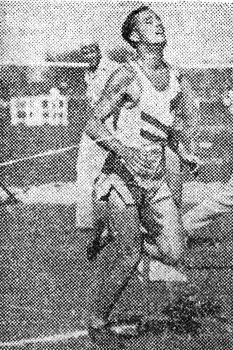 Winner of the mile run in the International Olympic Games staged at 1330 was Capt. Alexander Gordon, shown here
as he broke the tape in 4:47.
Winner of the mile run in the International Olympic Games staged at 1330 was Capt. Alexander Gordon, shown here
as he broke the tape in 4:47.
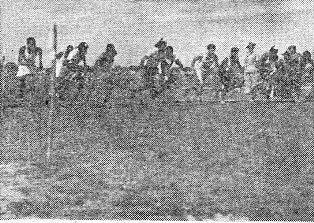
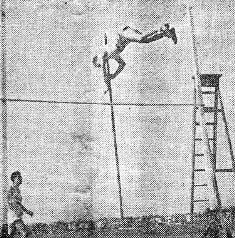

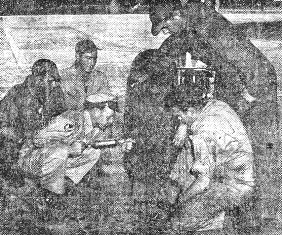 Capt. P. D. D. Cook, assistant division rubber coordinator, who developed ICD's new tire-dough-gun by adapting
an ordinary grease gun, instructs maintenance personnel in its use at the 1304 BU. Left to right are Cpl. James E.
Jensen, San Francisco; Sgt. Lester R. Fetzer, Williamsburg, Iowa; M/Sgt. Nobert R. Lenz, Ashton, Idaho, and S/Sgt.
Harold P. Lindquist, St. Joseph, Mo.
Capt. P. D. D. Cook, assistant division rubber coordinator, who developed ICD's new tire-dough-gun by adapting
an ordinary grease gun, instructs maintenance personnel in its use at the 1304 BU. Left to right are Cpl. James E.
Jensen, San Francisco; Sgt. Lester R. Fetzer, Williamsburg, Iowa; M/Sgt. Nobert R. Lenz, Ashton, Idaho, and S/Sgt.
Harold P. Lindquist, St. Joseph, Mo.

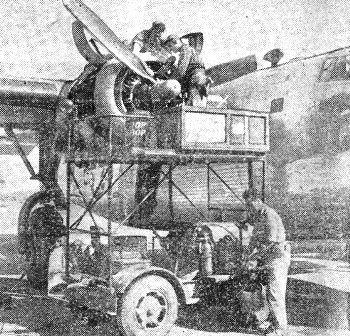 Mohammed comes to the mountain as this prop shop mounted on an engineering tug brings the tools and equipment
to the level of aircraft engines. It saves times and cracked shins from crawling around crew chief stands. Here its
creators, T/Sgt. Frank Prabel, Sgt. Hobert Montgomery and Pvt. Frank Collins, put it to use, pulling a prop from a
C-109.
Mohammed comes to the mountain as this prop shop mounted on an engineering tug brings the tools and equipment
to the level of aircraft engines. It saves times and cracked shins from crawling around crew chief stands. Here its
creators, T/Sgt. Frank Prabel, Sgt. Hobert Montgomery and Pvt. Frank Collins, put it to use, pulling a prop from a
C-109.
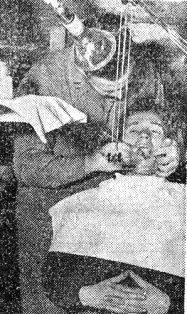 Pfc. Sam Skurow, inventive GI, made his points by building an instrument stand for Capt. T. N. Hamblen, 1339 dentist.
The molar-mauler is so grateful that he gives Skurow's grinders a thorough reaming. Now Skurow isn't sure he did the
right thing!
Pfc. Sam Skurow, inventive GI, made his points by building an instrument stand for Capt. T. N. Hamblen, 1339 dentist.
The molar-mauler is so grateful that he gives Skurow's grinders a thorough reaming. Now Skurow isn't sure he did the
right thing!
 One of the many tire removers built at various ICD bases by efficiency conscious maintenance men who constantly
active to decrease engineering problems. These GI-made "bead-breakers" cut tire change time to a minimum. Here Sgt.
John J. Robinson demonstrates how his particular model works.
One of the many tire removers built at various ICD bases by efficiency conscious maintenance men who constantly
active to decrease engineering problems. These GI-made "bead-breakers" cut tire change time to a minimum. Here Sgt.
John J. Robinson demonstrates how his particular model works.
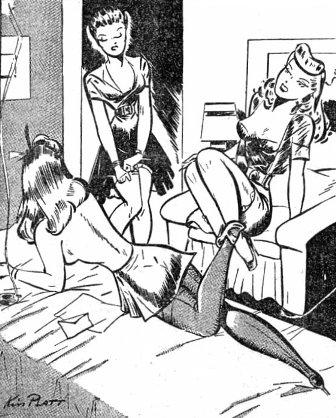 "I'm taking it easy this week - I'm jilting two bankers instead of five."
"I'm taking it easy this week - I'm jilting two bankers instead of five."